Double Crack Damage Identification of Welded Steel Structure Based on LAMB WAVES of S0 Mode
Abstract
:1. Introduction
2. Basic Theory of Lamb Waves
2.1. Basic Theory of Group Velocity and Phase Velocity
2.2. Dispersion Curve
3. Identification and Imaging of Double Crack Damage Based on the Lamb Waves of the S0 Mode
3.1. Geometric Model for Numerical Simulation
3.2. Excitation Signal
3.3. Mesh Size
3.4. Elliptical Location Method
3.5. Simulation Results
3.6. Experiment on the Identification of Double Crack Damage
4. Damage Identification of Welded Steel Plate Based on S0 Mode
4.1. Numerical Simulation
4.2. Numerical Simulation Results
4.3. Experiment
4.3.1. Experimental Results
4.3.2. Attenuation Analysis of Signal Energy
5. Conclusions
- The damage imaging results of the steel plate with double cracks from numerical simulation and experiments were in good agreement. The damage location shows a high level of accuracy. The mutual verification of finite element method and experiments proved the reliability of the Lamb waves monitoring method.
- When reflected by damages, Lamb waves had amplitude attenuation, which could be reflected in the echo signal. As can be seen from the imaging results of double damages, the differences in the damage length were quite obvious. It was proved that the method is sensitive to the length of damage. This will contribute to research on the length of the structures’ crack in further study.
- When studying damage location in welded steel plates, it is concluded that a part of the Lamb waves would reflect at the weld and would partly pass through the weld. The results of numerical simulation and experiments confirm this inference. The agreement of simulation results and experimental results prove the feasibility of the application of the Lamb wave method in the welded structure.
- By analysing the amplitude and distance of the signal in the welded steel plate, it is concluded that the energy of Lamb wave in the steel plate decreased with the increment of the distance. The welding seam reflected most Lamb waves, and the energy considerably reduced when they passed through the welding seam during the propagation process.
Author Contributions
Funding
Conflicts of Interest
References
- Sikdar, S.; Mirgal, P.; Banerjee, S.; Ostachowicz, W. Damage-induced acoustic emission source monitoring in a honeycomb sandwich composite structure. Compos. Part B Eng. 2019, 158, 179–188. [Google Scholar] [CrossRef]
- Kundu, A.; Eaton, M.J.; Al-Jumali, S.; Sikdar, S.; Pullin, R. Acoustic emission based damage localization in composites structures using Bayesian identification. In Proceedings of the 12th International Conference on Damage Assessment of Structures (DAMAS), Kitakyushu, Japan, 10–12 July 2017. [Google Scholar]
- Sikdar, S.; Ostachowicz, W.; Pal, J. Damage-induced acoustic emission source identification in an advanced sandwich composite structure. Compos. Struct. 2018, 202, 860–866. [Google Scholar] [CrossRef]
- Li, R.; Li, H.; Hu, B. Damage Identification of Large Generator Stator Insulation Based on PZT Sensor Systems and Hybrid Features of Lamb Waves. Sensors 2018, 18, 2745. [Google Scholar] [CrossRef] [PubMed]
- Zhu, W.; Xiang, Y.; Liu, C.; Deng, M.; Xuan, F. A feasibility study on fatigue damage evaluation using nonlinear Lamb waves with group-velocity mismatching. Ultrasonics 2018, 90, 18–22. [Google Scholar] [CrossRef] [PubMed]
- Acuna, D.Q.; Vicuna, C.M. Damage Assessment of Rolling Element Bearing Using Cyclostationary Processing of AE Signals with Electromagnetic Interference. In Proceedings of the 7th Workshop on Cyclostationary Systems and Their Applications, Grodek, Poland, 9–12 February 2014; Springer: Berlin, Germany, 2015; pp. 43–54. [Google Scholar]
- Lamb, H. On waves in an elastic plate. Proc. Royal Soc. Lond. 1917, 93, 114–128. [Google Scholar] [CrossRef] [Green Version]
- Wang, C.H.; Rose, J.T.; Chang, F.-K. A synthetic time-reversal imaging method for structural health monitoring. Smart Mater. Struct. 2004, 13, 415–423. [Google Scholar] [CrossRef]
- He, J.; Yang, L.; Sun, X.; Hu, M. Damage identification in welded structures using symmetric excitation of Lamb waves. Adv. Mech. Eng. 2018, 10, 1687814018794817. [Google Scholar] [CrossRef]
- Alkassar, Y.; Agarwal, V.; Alshrihi, E. Simulation of Lamb Wave Modes Conversions in a Thin Plate for Damage Detection. Procedia Eng. 2017, 173, 948–955. [Google Scholar] [CrossRef]
- Yanyu, M.; Shi, Y.; Meng, Y.; Yan, S. Thin Plate Lamb Propagation Rule And Dispersion Curve Drawing Based On Wave Theory. Surf. Lett. 2018, 18502220. [Google Scholar] [CrossRef]
- Li, F.; Meng, G.; Ye, L.; Lu, Y.; Kageyama, K. Dispersion analysis of Lamb waves and damage detection for aluminum structures using ridge in the time-scale domain. Meas. Sci. Technol. 2009, 20, 95704. [Google Scholar] [CrossRef]
- Hosseinabadi, H.Z.; Amirfattahi, R.; Nazari, B.; Mirdamadi, H.R.; Atashipour, S.A. GUW-based structural damage detection using WPT statistical features and multiclass SVM. Appl. Acoust. 2014, 86, 59–70. [Google Scholar] [CrossRef]
- Amjad, U.; Yadav, S.K.; Kundu, T. Detection and quantification of pipe damage from change in time of flight and phase. Ultrasonics 2015, 62, 223–236. [Google Scholar] [CrossRef] [PubMed]
- Zeng, L.; Huang, L.; Lin, J. Damage imaging of composite structures using multipath scattering Lamb waves. Compos. Struct. 2019, 216, 331–339. [Google Scholar] [CrossRef]
- Takpara, R.; Duquennoy, M.; Ouaftouh, M.; Courtois, C.; Jenot, F.; Rguiti, M. Optimization of PZT ceramic IDT sensors for health monitoring of structures. Ultrasonics 2017, 79, 96–104. [Google Scholar] [CrossRef] [PubMed]
- Sun, M.J.; Liu, T.; Cheng, X.Z.; Chen, D.Y.; Yan, F.G.; Feng, N.Z. Nondestructive detecting method for metal material defects based on multimodal signals. ACTA Phys. Sci. 2018, 65. [Google Scholar] [CrossRef]
- Masurkar, F.A.; Yelve, N.P. Optimizing location of damage within an enclosed area defined by an algorithm based on the Lamb wave response data. Appl. Acoust. 2017, 120, 98–110. [Google Scholar] [CrossRef]
- Borneman, S.R.; Hashemi, S.M. Vibration-Based, Nondestructive Methodology for Detecting Multiple Cracks in Bending-Torsion Coupled Laminated Composite Beams. Shock. Vib. 2018, 2018, 1–10. [Google Scholar] [CrossRef]
- De Luca, A.; Perfetto, D.; De Fenza, A.; Petrone, G.; Caputo, F. Guided waves in a composite winglet structure: Numerical and experimental investigations. Compos. Struct. 2019, 210, 96–108. [Google Scholar] [CrossRef]
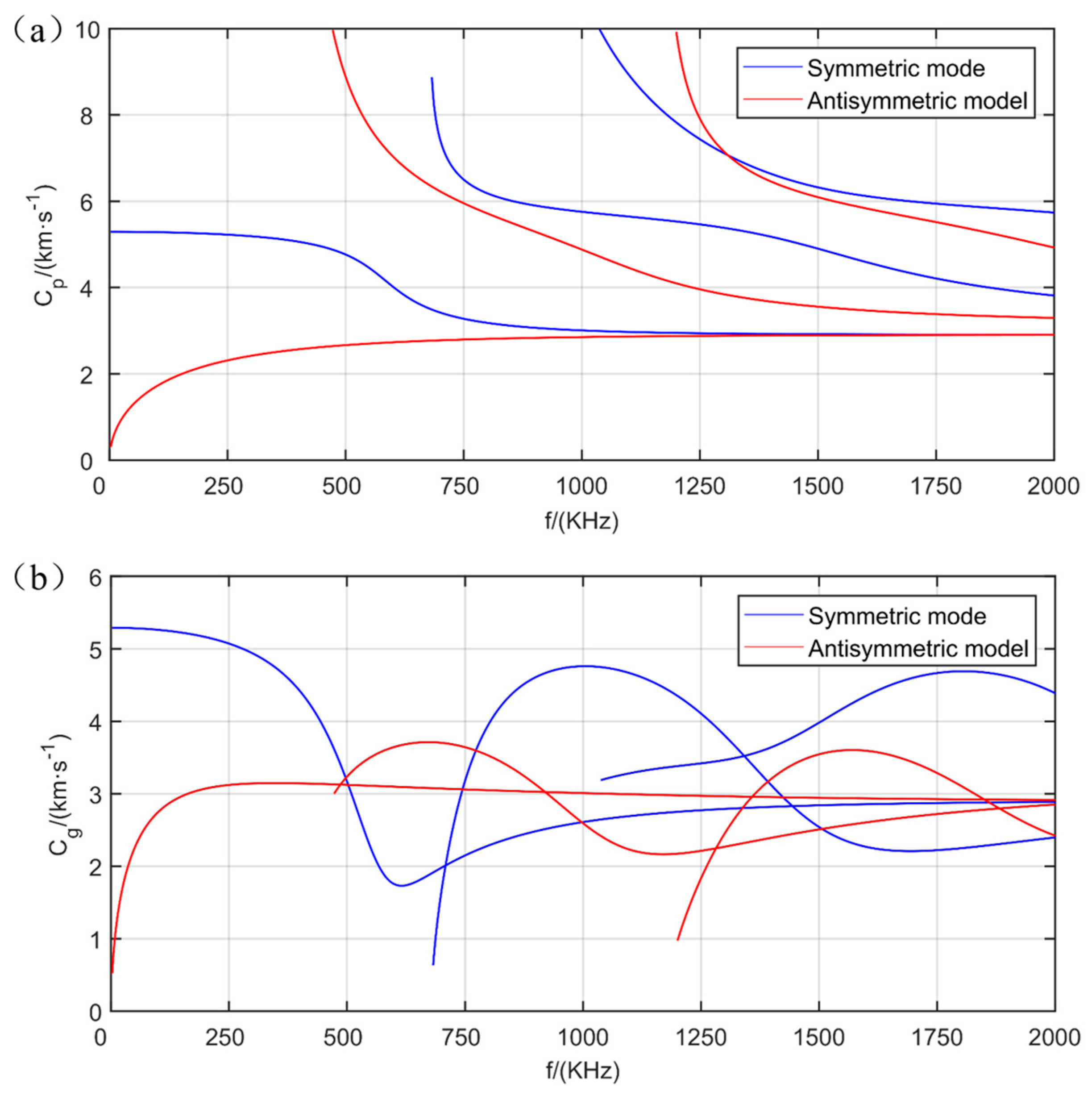





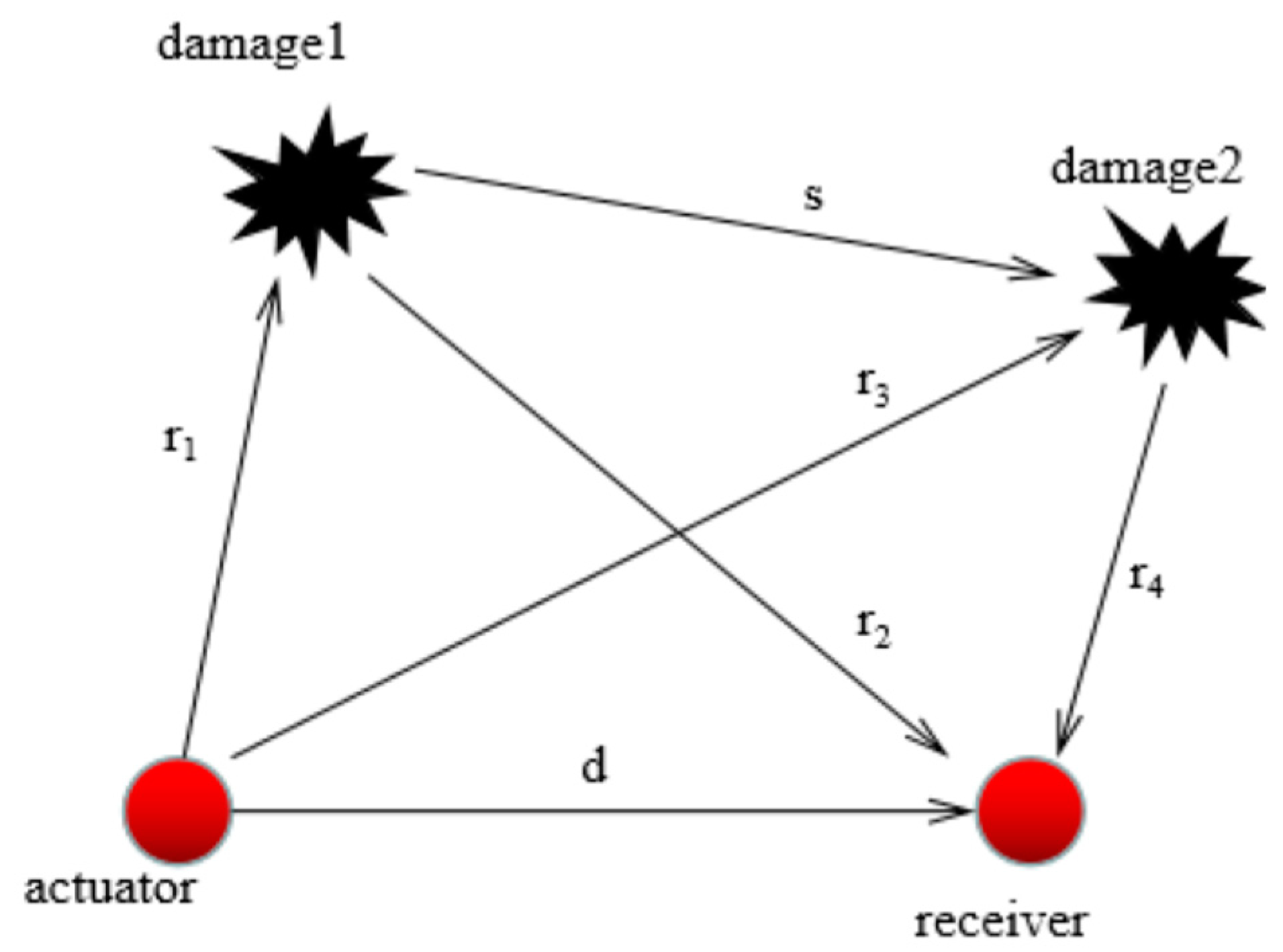
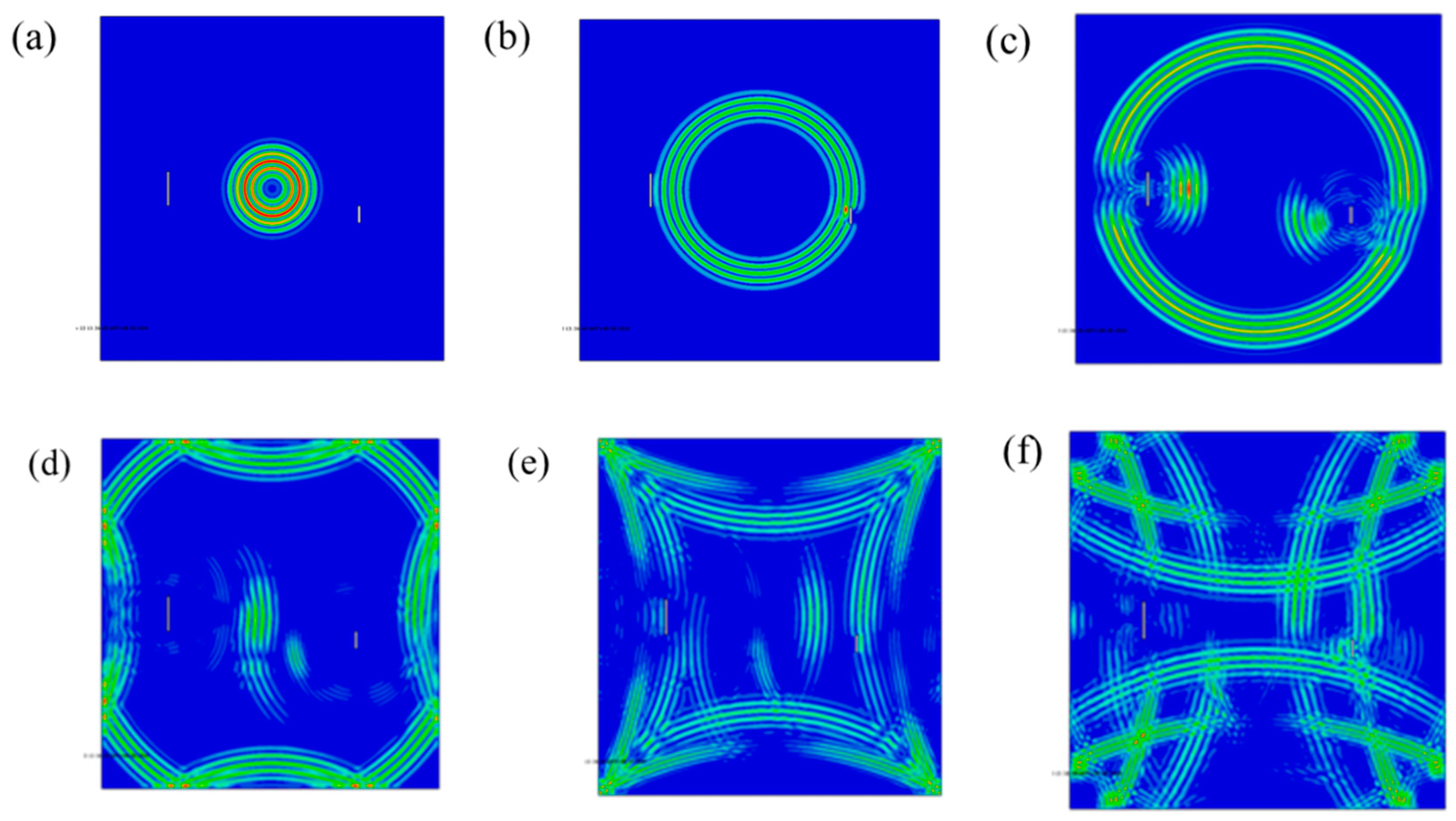
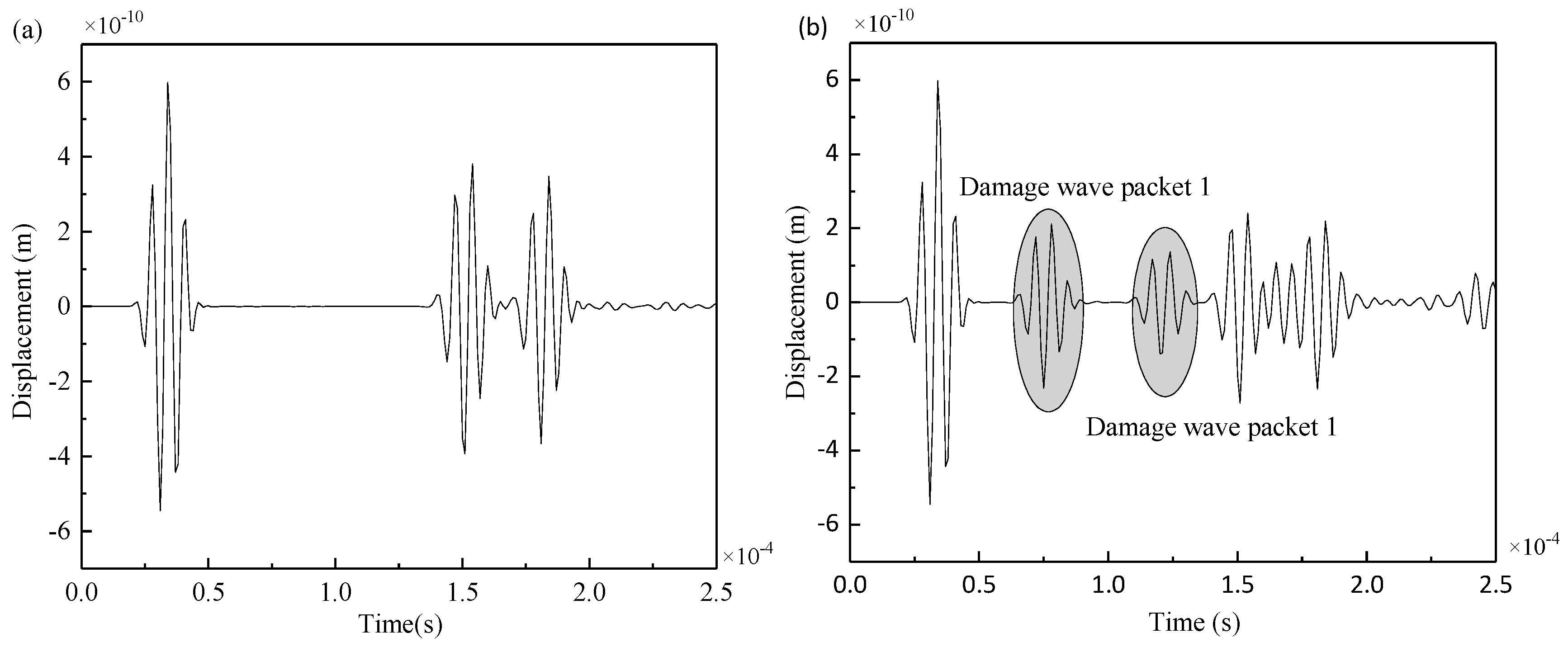

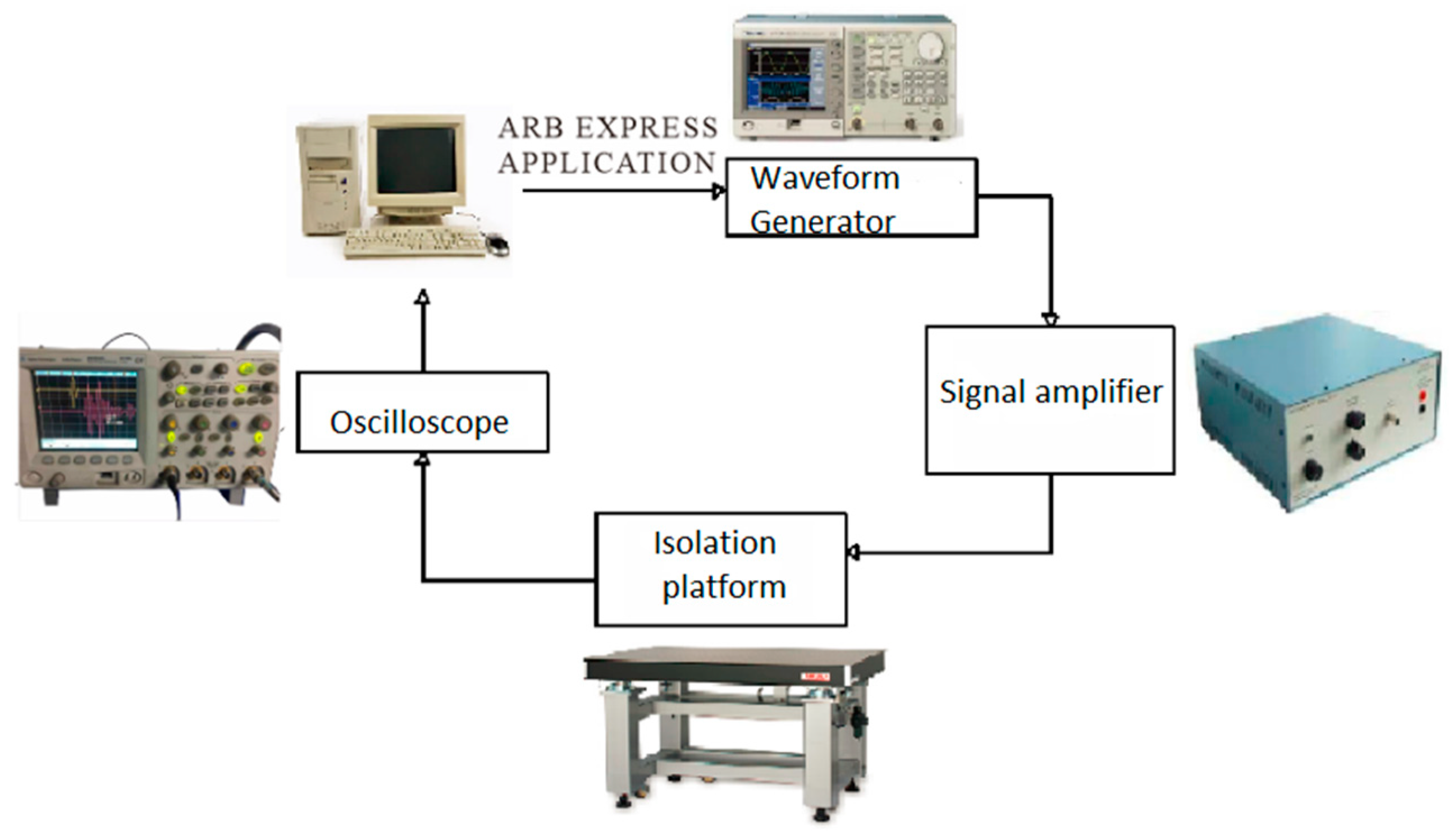
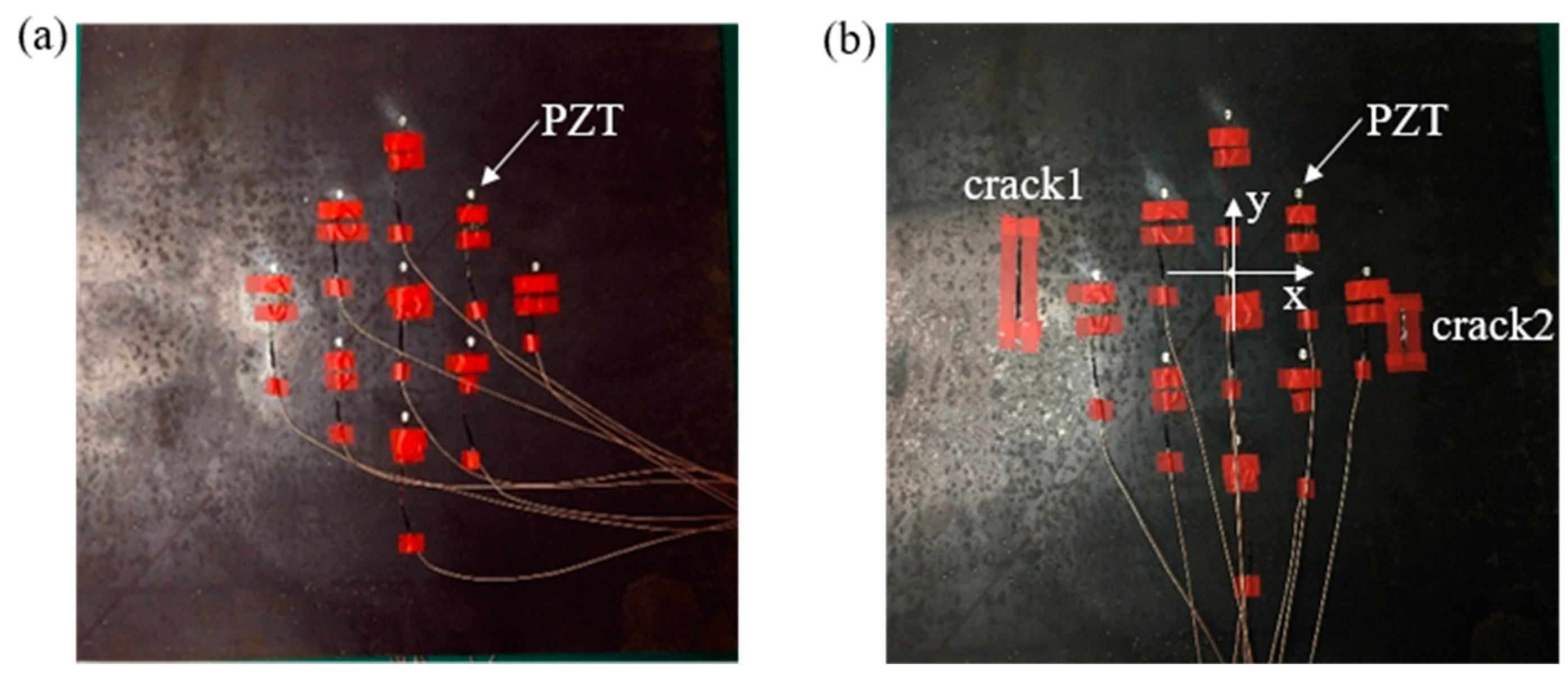
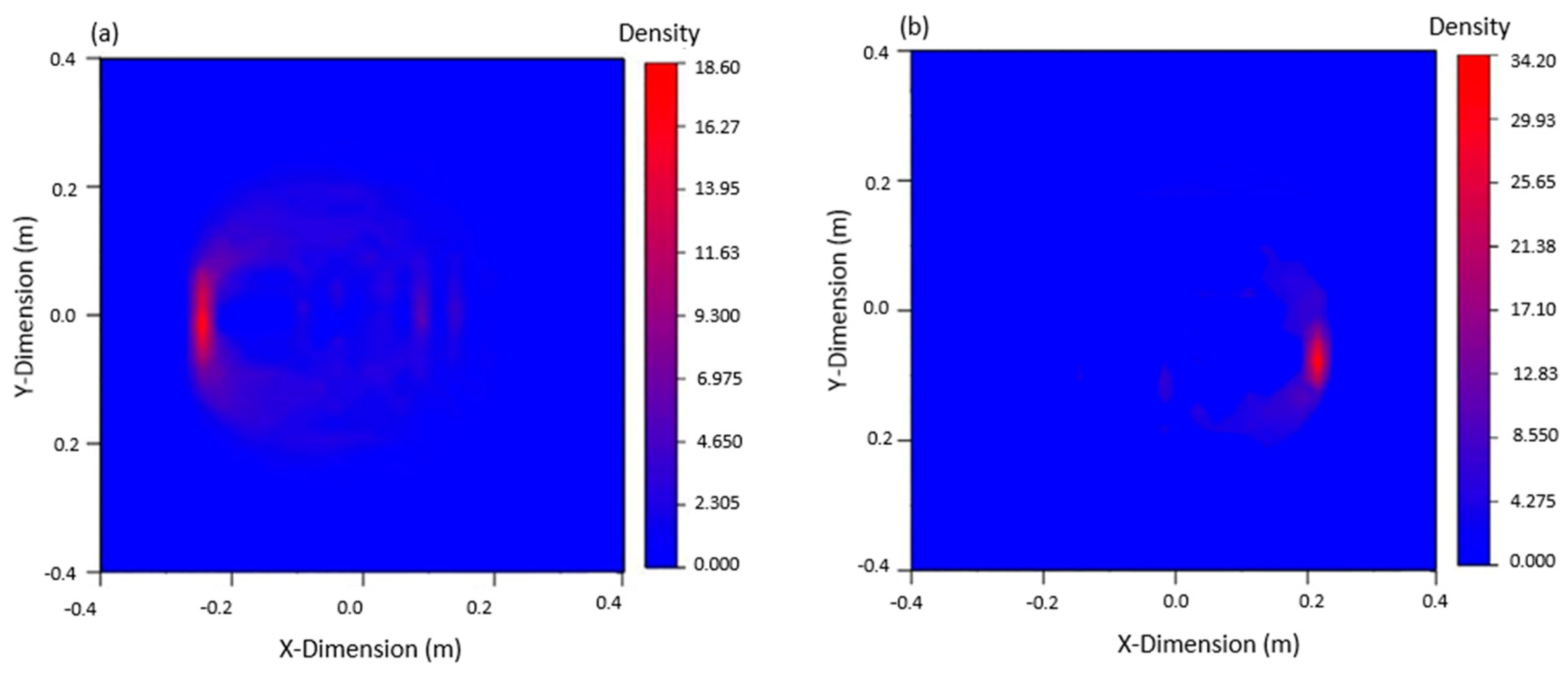

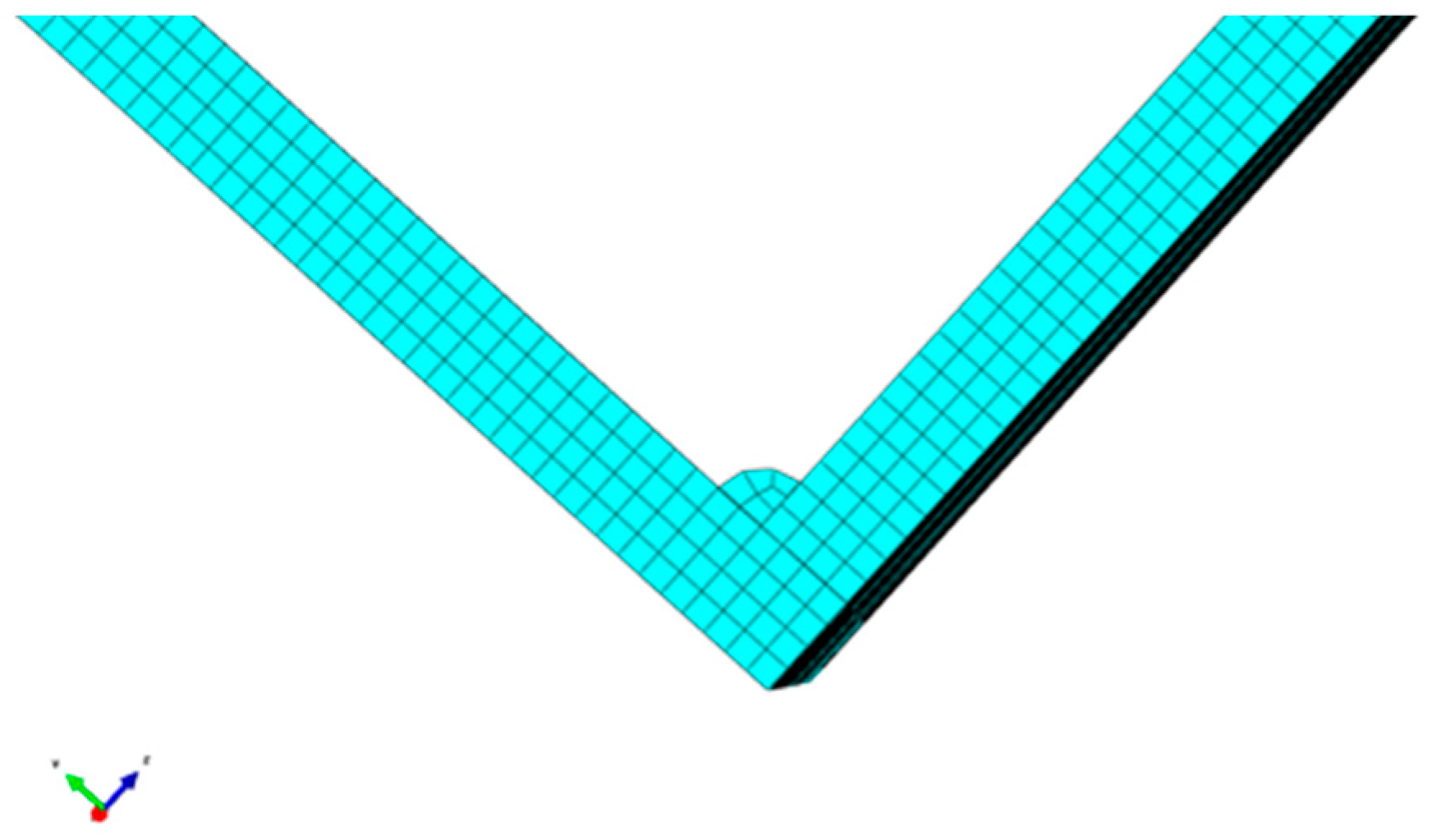
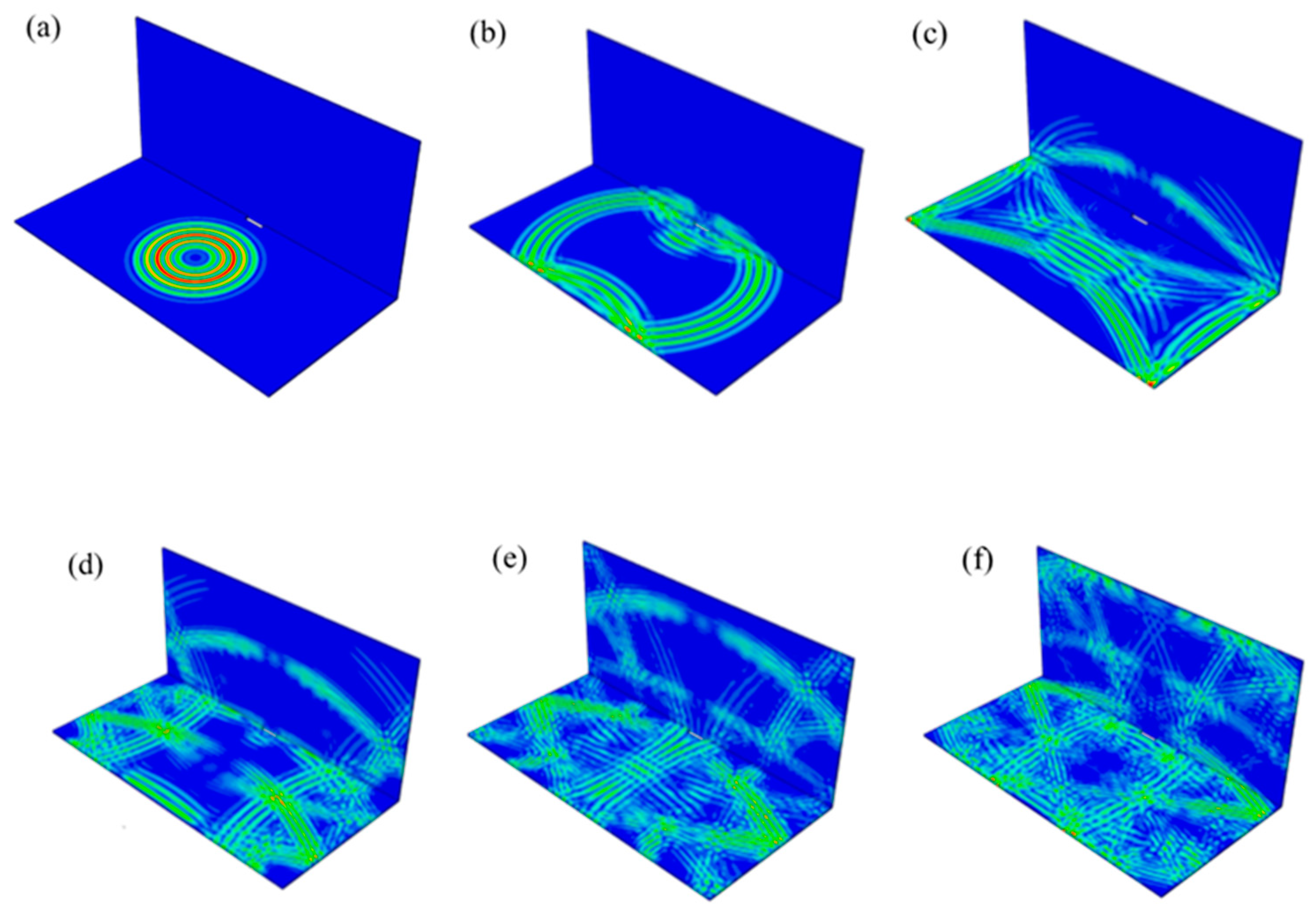

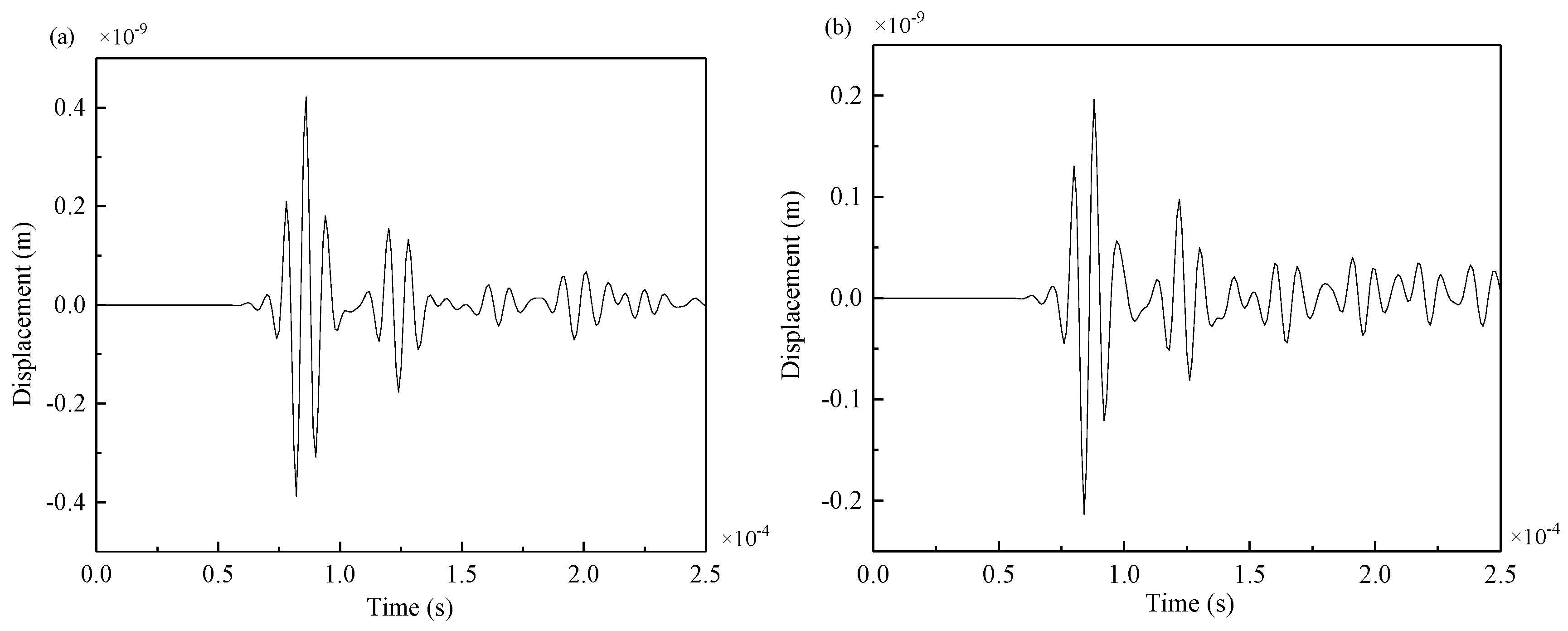
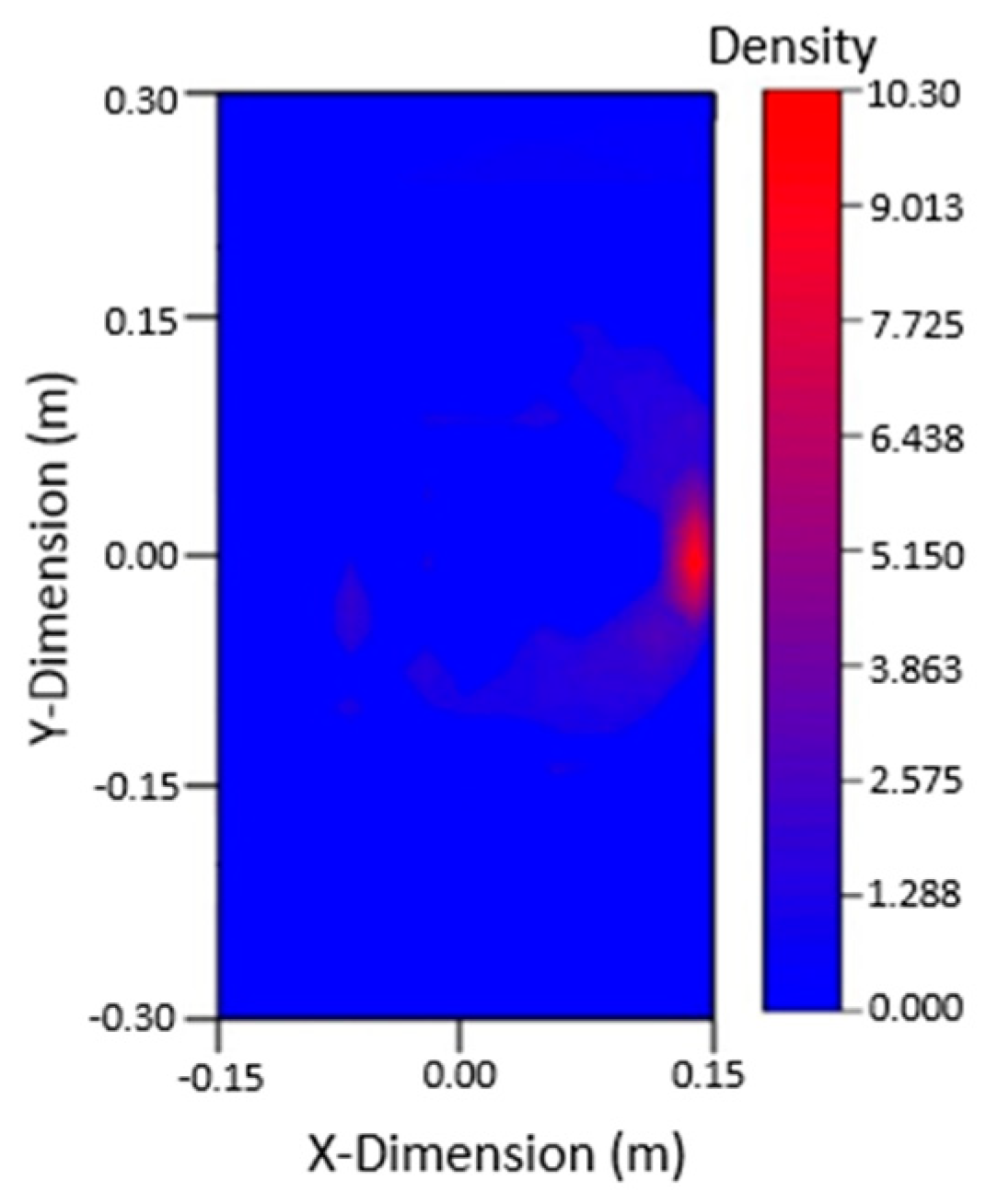

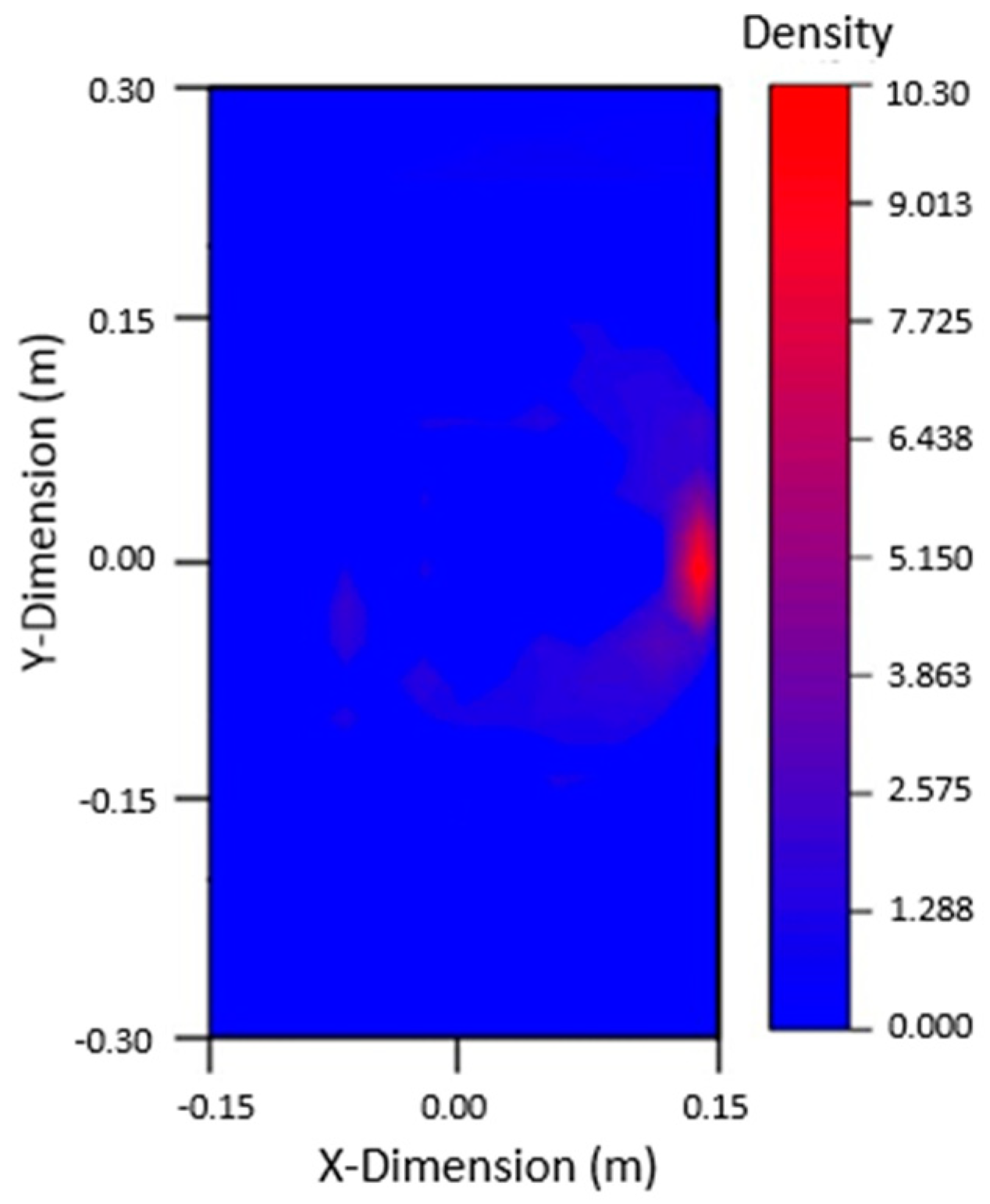

| E (GPa) | ν | ρ (kg/m3) | d (mm) | cL (m/s) | cT (m/s) |
|---|---|---|---|---|---|
| 206 | 0.25 | 7800 | 4 | 5856 | 3130 |
| Transducer | Coordinate (mm) | Transducer | Coordinate (mm) | Transducer | Coordinate (mm) |
|---|---|---|---|---|---|
| PZT1 | (0,160) | PZT4 | (−160,0) | PZT7 | (−80,−80) |
| PZT1’ | (0,160) | PZT4’ | (−160,0) | PZT7’ | (−80,−80) |
| PZT2 | (−80,80) | PZT5 | (0,0) | PZT8 | (80,−80) |
| PZT2’ | (−80,80) | PZT5’ | (0,0) | PZT8’ | (80,−80) |
| PZT3 | (80,80) | PZT6 | (160,0) | PZT9 | (0,−160) |
| PZT3’ | (−80,80) | PZT6’ | (160,0) | PZT9’ | (0,−160) |
| Transducer (Left Side) | Coordinate (mm) (x,y) | Transducer (Left Side) | Coordinate (mm) (x,y) | Transducer (Right Side) | Coordinate (mm) (x’,y’) |
|---|---|---|---|---|---|
| PZT1 | (0,50) | PZT3’ | (0,0) | PZT6 | (0,50) |
| PZT1’ | (0,50) | PZT4 | (100,0) | PZT7 | (−100,0) |
| PZT2 | (−100,0) | PZT4’ | (100,0) | PZT8 | (0,0) |
| PZT2’ | (−100,0) | PZT5 | (0,−50) | PZT9 | (100,0) |
| PZT3 | (0,0) | PZT5’ | (0,−50) | PZT10 | (0,−50) |
| Propagation Path | Distance (mm) | Voltage (V) ×10−3 | Propagation Path | Distance (mm) | Voltage (V) ×10−3 |
|---|---|---|---|---|---|
| PZT1–PZT2 | 112 | 4.014 | PZT1–PZT7 | 380 | 0.210 |
| PZT1–PZT3 | 50 | 6.565 | PZT1–PZT8 | 350 | 0.305 |
| PZT1–PZT4 | 112 | 3.210 | PZT1–PZT9 | 380 | 0.242 |
| PZT1–PZT5 | 100 | 6.112 | PZT1–PZT10 | 300 | 0.672 |
| PZT1–PZT6 | 400 | 0.198 |
| Propagation Path | Distance (mm) | Displacement (mm) ×10−9 | Propagation Path | Distance (mm) | Displacement (mm) ×10−9 |
|---|---|---|---|---|---|
| PZT1–PZT2 | 112 | 1.076 | PZT1–PZT7 | 380 | 0.2608 |
| PZT1–PZT3 | 50 | 4.642 | PZT1–PZT8 | 350 | 0.3105 |
| PZT1–PZT4 | 112 | 1.078 | PZT1–PZT9 | 380 | 0.2819 |
| PZT1–PZT5 | 100 | 2.679 | PZT1–PZT10 | 300 | 0.4221 |
| PZT1–PZT6 | 400 | 0.2283 |
© 2019 by the authors. Licensee MDPI, Basel, Switzerland. This article is an open access article distributed under the terms and conditions of the Creative Commons Attribution (CC BY) license (http://creativecommons.org/licenses/by/4.0/).
Share and Cite
Hu, M.; Sun, X.; He, J.; Zhan, Y. Double Crack Damage Identification of Welded Steel Structure Based on LAMB WAVES of S0 Mode. Materials 2019, 12, 1800. https://doi.org/10.3390/ma12111800
Hu M, Sun X, He J, Zhan Y. Double Crack Damage Identification of Welded Steel Structure Based on LAMB WAVES of S0 Mode. Materials. 2019; 12(11):1800. https://doi.org/10.3390/ma12111800
Chicago/Turabian StyleHu, Muping, Xiaodan Sun, Jian He, and Yangyang Zhan. 2019. "Double Crack Damage Identification of Welded Steel Structure Based on LAMB WAVES of S0 Mode" Materials 12, no. 11: 1800. https://doi.org/10.3390/ma12111800
APA StyleHu, M., Sun, X., He, J., & Zhan, Y. (2019). Double Crack Damage Identification of Welded Steel Structure Based on LAMB WAVES of S0 Mode. Materials, 12(11), 1800. https://doi.org/10.3390/ma12111800





